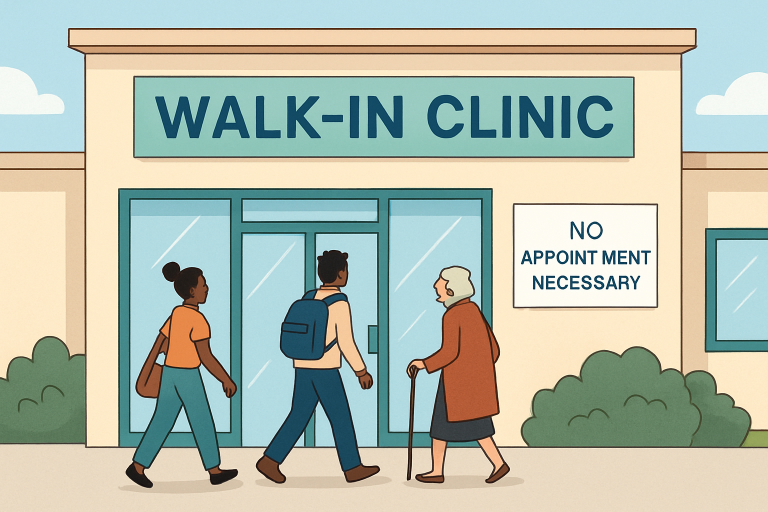Key Takeaways
- Walk-in clinics provide convenient and timely medical care, reducing the burden on emergency departments.
- Integration of telemedicine and AI enhances the efficiency and reach of walk-in clinics.
- These clinics are expanding services to include preventive care and chronic disease management.
- Technological advancements are improving patient experience and operational efficiency.
Walk-in clinics are transforming healthcare by providing convenient, efficient, and affordable access as an alternative to crowded ERs and long waits for primary care. Their popularity is growing among those seeking quick and reliable care. Whether you need treatment for a minor injury or are looking to address a sudden illness, finding urgent care near me is easier than ever, allowing patients to prioritize their health without major disruptions to their daily routines.
Walk-in clinics simplify care for non-life-threatening issues with flexible hours, avoiding appointment delays. They help ease emergency department pressure and adapt through new technologies, offering preventive and chronic care, thus broadening access and service scope.

The Rise of Walk-In Clinics
The rapid expansion of walk-in clinics is transforming immediate healthcare. In an era where waiting weeks for a doctor’s appointment can exacerbate health issues, these clinics efficiently bridge the gap between primary care and emergency services.
With an emphasis on same-day access, walk-in clinics are designed for patients seeking prompt evaluation and treatment for minor injuries, infections, and routine care needs.
This patient-centered approach is a direct response to evolving expectations in healthcare. With consumers prioritizing speed, flexibility, and high standards of care, health systems have had to innovate to keep pace.
Technological Advancements in Walk-In Clinics
The integration of digital tools and telehealth is transforming walk-in clinics. Online booking and digital check-ins reduce delays, enabling patients to see a doctor soon after arrival. EHRs allow quick access to medical histories, improving diagnosis and care. Telemedicine broadens reach, especially in underserved areas, allowing remote consultations for assessments, prescriptions, or follow-ups.
During the pandemic, telemedicine at urgent care clinics more than doubled and remains popular as virtual healthcare becomes standard.
Expanding Services Beyond Immediate Care
Walk-in clinics now offer a wider range of services beyond acute care, including vaccinations, exams, and screenings. This helps catch health issues early and manage chronic conditions like diabetes and hypertension. Easy access to routine care promotes ongoing patient-provider relationships, supporting value-based healthcare and better community health.
Impact on Emergency Departments
A significant benefit of walk-in clinics is their ability to divert non-emergency cases from overcrowded emergency departments. Emergency rooms are often overwhelmed by patients who may not require critical care, leading to longer wait times and stretched resources for true emergencies.
Walk-in clinics offer a safe alternative for these lower-acuity cases, allowing hospital-based emergency staff to focus on more severe and life-threatening conditions. This relief not only improves patient flow but also patient satisfaction and quality of care across healthcare systems. For example, the implementation of walk-in clinics by health networks has tangibly reduced ER visits for non-urgent issues, thereby improving resource allocation across the board.
Cost-Effectiveness and Accessibility
The affordability of walk-in care compared to emergency room visits boosts its popularity. Walk-in clinics charge less than hospitals for urgent services and accept various insurance plans at co-pay rates. This model helps patients avoid high costs, addresses healthcare disparities, and promotes earlier care. Accessibility is increased by clinics’ strategic locations in retail centers, neighborhoods, and high-traffic areas, with extended hours. These factors collectively reduce traditional barriers to care.
Future Prospects and Challenges
Looking forward, walk-in clinics are poised to play an increasingly critical role in healthcare delivery. The fusion of artificial intelligence, predictive analytics, and ongoing innovations will further personalize care and streamline clinic operations.
However, sustained growth will require addressing ongoing challenges: ensuring consistent care quality, securing patient data, integrating clinic records across systems, and safeguarding equity in healthcare delivery. Navigating these issues is essential for maximizing the benefits of immediate care models and broadening their impact throughout the healthcare ecosystem.
Immediate Access to Healthcare
Walk-in clinics eliminate the most frustrating aspect of traditional healthcare: waiting for appointments. Patients with acute conditions receive treatment within hours, not days or weeks. This immediacy proves critical for conditions requiring prompt attention but not emergency intervention.
The first-come, first-served system ensures fairness while maintaining operational efficiency. Patients understand the transparent process, reducing anxiety about when they’ll receive care. Modern clinics employ digital check-in systems, allowing patients to reserve spots remotely and minimize physical waiting time.
This accessibility particularly benefits parents with sick children who cannot predict when illness will strike. Similarly, individuals with unpredictable work schedules find relief knowing medical care remains available without advance planning.
Reduced Emergency Room Burden
Walk-in clinics divert non-emergency cases from overwhelmed emergency departments. This redistribution benefits the entire healthcare ecosystem by ensuring emergency resources remain available for truly critical cases.
Emergency rooms often treat minor conditions at tremendous cost, both financially and in terms of resource allocation. When patients with ear infections or minor lacerations visit walk-in clinics instead, emergency departments can focus on heart attacks, strokes, and trauma cases.
This shift improves outcomes for all patients. Emergency cases receive faster attention, while non-emergency patients avoid lengthy emergency room waits that can stretch eight hours or more.
Transparent Pricing Models
Unlike traditional healthcare settings where bills arrive weeks later, walk-in clinics often display prices for common procedures. This transparency empowers patients to make informed decisions about their care.
Most clinics post prices for services like strep throat treatment, minor suture placement, or sports physicals. Patients know costs upfront, eliminating the anxiety of surprise medical bills that plague American healthcare.
This transparency extends to insurance coverage. Clinics clearly communicate copayment amounts and which services insurance covers, preventing financial surprises that discourage future healthcare seeking.
Comparative Cost Analysis
Emergency room visits for minor conditions can exceed $2,000, while walk-in clinics typically charge $100-200 for similar treatments. This dramatic difference makes healthcare financially viable for middle-class families facing high-deductible insurance plans.
Consider treating a urinary tract infection: an emergency room visit might cost $1,500-2,500, while a walk-in clinic charges $75-150. The same antibiotics, the same outcome, but at a fraction of the cost.
Companies increasingly partner with walk-in clinics to reduce employee healthcare costs and minimize work absences. Employees receive faster treatment and return to work sooner, benefiting both parties through reduced premiums and maintained productivity.
Extended Operating Hours
Most walk-in clinics operate until 8 or 9 PM, accommodating working professionals who cannot visit during traditional office hours. This scheduling flexibility prevents productivity loss and reduces the economic impact of illness.
Weekend availability ensures continuous care access, particularly important for pediatric cases where conditions can worsen rapidly. Parents no longer face the dilemma of waiting until Monday or visiting the emergency room for non-critical weekend illnesses.
Holiday hours at many clinics provide crucial access when traditional offices close for extended periods. This continuity prevents condition deterioration that occurs when patients delay treatment.
Strategic Location Placement
Walk-in clinics within pharmacies and retail stores leverage existing foot traffic and provide convenient one-stop healthcare solutions. Patients receive diagnosis, prescription, and medication in a single visit, maximizing convenience.
Strategic placement in underserved communities addresses healthcare deserts where traditional medical facilities are scarce. This geographic distribution promotes health equity by bringing healthcare to populations historically lacking access.
Urban clinics near public transportation and suburban locations with ample parking consider patient convenience in site selection. Accessibility extends beyond operating hours to include physical accessibility.
Comprehensive Service Offerings
Walk-in clinics increasingly offer vaccinations, health screenings, and basic preventive care. This expansion beyond acute care creates comprehensive community health hubs serving diverse medical needs.
Some clinics now provide follow-up care for stable chronic conditions, offering medication refills and routine monitoring between specialist appointments. This service prevents gaps in chronic disease management.
Sports physicals, employment screenings, and travel medicine consultations round out service offerings. These additions position walk-in clinics as versatile healthcare providers beyond simple acute care.
Advanced Diagnostic Capabilities
Modern walk-in clinics feature laboratory services and basic imaging capabilities. Rapid strep tests, flu tests, and X-rays provide immediate diagnostic information, expediting treatment decisions.
Point-of-care testing delivers results within minutes rather than days. Patients leave with definitive diagnoses and appropriate treatment, avoiding the uncertainty of waiting for laboratory results.
Advanced clinics connect patients with specialists via telemedicine, expanding diagnostic and treatment capabilities beyond on-site resources. This technology integration brings specialist expertise to community settings.
Quality Staffing Models
Most walk-in clinics employ nurse practitioners and physician assistants supervised by physicians. These professionals competently manage conditions typically presenting at walk-in facilities while maintaining quality standards.
Established referral relationships with specialists and hospitals ensure seamless care transitions when conditions exceed clinic capabilities. Providers recognize their scope limitations and facilitate appropriate referrals.
Continuous training keeps staff current with treatment guidelines and emerging health threats. This commitment to education maintains care quality despite the high-volume, fast-paced environment.
Electronic Health Integration
Digital records facilitate information sharing between walk-in clinics and primary care providers, ensuring continuity of care despite episodic visit patterns. This integration prevents treatment duplication and medication errors.
Electronic systems enable quality monitoring and improvement initiatives, elevating care standards across clinic networks. Data analytics identify trends and opportunities for service enhancement.
Patient portals provide visit summaries and test results electronically. This digital access empowers patients to manage their health information and share it with other providers.
Public Health Contributions
Walk-in clinics serve as early warning systems for infectious disease outbreaks, providing real-time epidemiological data to public health authorities. This surveillance capability proved invaluable during COVID-19 and seasonal flu outbreaks.
Convenient vaccination services increase immunization rates, particularly for seasonal influenza and travel vaccines. Easy access removes barriers that prevent vaccination compliance.
Health education provided during visits promotes preventive care and healthy behaviors. These brief interventions accumulate into significant public health impact.
Future Innovation Potential
AI-powered triage systems will optimize patient flow and improve diagnostic accuracy, further enhancing clinic efficiency. Machine learning algorithms will predict wait times and suggest optimal visit timing.
Integrated mobile applications will enable remote check-in, virtual queuing, and follow-up care coordination. These technologies will create seamless healthcare experiences extending beyond physical visits.
Expansion into chronic disease management and mental health services will broaden walk-in clinic scope. This evolution positions clinics as comprehensive primary care alternatives rather than solely acute care providers.
Conclusion
Walk-in clinics are essential hubs of accessible, efficient, and forward-thinking healthcare. Their influence on the broader system extends beyond simply alleviating emergency room strain—they provide community-based solutions that promote preventive care, offer affordable treatments, and keep pace with technological advancements.
As healthcare needs evolve, walk-in clinics are well-positioned to shape the future of immediate care, matching the expectations of today’s healthcare consumers while building healthier communities for tomorrow.

